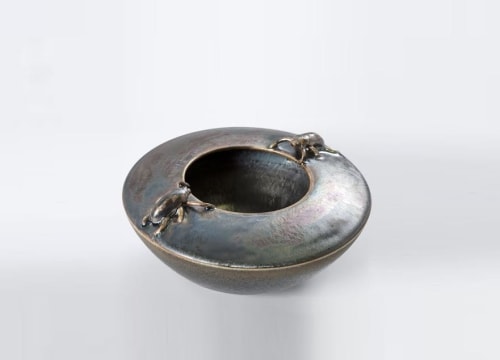
Jean Girel — ceramist, poet, technician, dreamer — credits such disparate influences as the rich soil of his native hills, the metallic sheen of oil slicks, and the extraordinary ceramics of the Song Dynasty. The latter, made in China between 960 and 1279, are revered for their elegant simplicity of form and the complicated and varied technologies required to produce their lush glazes. This powerful alchemy of earth, water and fire inspired Girel’s quest to uncover the mysteries of the universe through his own work in ceramics.
Born in Savoie in 1947, Girel apprenticed with a traditional potter at age 14, then studied at the Ecole des Beaux-Arts in Mâcon, earned a degree in visual arts in Paris and became a painter. By 1975, however, he was devoting himself exclusively to ceramics. With characteristic intensity, Girel began the unorthodox practice of making his own porcelain paste and experimenting with natural materials to create unique glazes. He spent decades developing original recipes, protocols and tools —including designing and building seventeen of his own kilns—and in the process became a master in his field, published author and sought-after authority. For his wealth of knowledge—and passion for sharing it with others— Girel was named Maître d’Art in 2000 by the French Minister of Culture, one of just two ceramists ever to receive this honor; later he was also made Chevalier des Arts et des Lettres. In 2004, Girel and his wife, fellow ceramist Valérie Hermans, were invited to the National Palace Museum of Taipei in Taiwan, renowned for its prestigious collection of Chinese antiquities. Girel was recognized as a national living treasure and, in an unprecedented honor for a contemporary artist, the museum opened its own Jean Girel gallery, acquiring eleven of his pieces to showcase there.
The great diversity and originality of Girel’s work is the result of his wholly unique approach. His techniques are not found in any ceramics textbook, but in the laboratory of his mind. His materials are not procured from the usual suppliers; the clay and minerals come from the hills around his home and are excavated in his travels. His art is of the earth, quite literally. He observes natural phenomena and attempts to replicate in his kiln the “secret metamorphoses of the planet”. And he succeeds in the way that all great artists do: by illuminating the unknown and making the familiar newly compelling.
Were it not for the tiny animals like little clues perched on the lids of the pieces in his Bestiaire series, the delicate patterns might seem merely to be beautiful yet random designs, instead of the marvelously accurate and intricately textured renderings of reptile skins and mottled pelts. In recreating the skins of creatures as diverse as leopards and hippopotami, Girel systematically explores new firing techniques, opening the kiln door at random to introduce drops of water or a gust of air.
Bird feathers, especially those of the peacock, a traditional decorative motif, helped Girel understand light and its relationship to the structure of matter. This led to the Oiseauxseries and new firing techniques that illuminated an avian universe of iridescent rainbows and shimmering oil slicks. In pursuit of the iridescence he had seen on Song pieces and in pictures of yohen temmoku bowls from Japan, Girel experimented further with firing and cooling processes, as well as with the use of iron and powdered rock to achieve the murky brilliance and lava-like flows of the Métallescencesseries.
The poetry of the northern Renaissance landscapes of Joachim Patinir sent Girel in pursuit of a new strategy, determined to find the third dimension in glazing. For his Paysages series, he caused “little accidents” in the glaze, breaches to allow the mineral layers to creep in, creating the striations so evocative of earth and sky. The work is pure abstraction; its vitrified incarnation anticipated but never certain until the moment it emerges from the kiln.